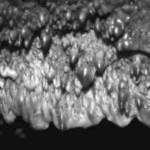Weliange W.S1 & Pathmakumara Jayasingha2
 Speleothems are mineral deposits found in caves and karsts, which are classified and named, based on the type of formation, mineral constituents and morphology. Limestone caves are famous since its speleothems are made up of various carbonate compounds. Most of the caves of Sri Lanka have been formed in high grade silicate rocks commonly known as Gneisses. Chemical weathering of silicate rocks are different. Therefore speleothems in gneissic caves are unique. Under the auspicious of the Post Graduate Institute of Archaeology, about 10 gneissic caves located in Rathnapura, Kuruwita, Ruwanwella and Mahiyanganaya areas in Sri Lanka were investigated. Discovered speleothems were mainly stalactites, stalagmites, and flowstone and in addition curtains, ridges and rim pools like structures were also recorded. Comparative an
Speleothems are mineral deposits found in caves and karsts, which are classified and named, based on the type of formation, mineral constituents and morphology. Limestone caves are famous since its speleothems are made up of various carbonate compounds. Most of the caves of Sri Lanka have been formed in high grade silicate rocks commonly known as Gneisses. Chemical weathering of silicate rocks are different. Therefore speleothems in gneissic caves are unique. Under the auspicious of the Post Graduate Institute of Archaeology, about 10 gneissic caves located in Rathnapura, Kuruwita, Ruwanwella and Mahiyanganaya areas in Sri Lanka were investigated. Discovered speleothems were mainly stalactites, stalagmites, and flowstone and in addition curtains, ridges and rim pools like structures were also recorded. Comparative an
alyses showed that the caves located in wet zone are more prone to form speleothems than the dry zone caves. In the dry-zone of Mahiyanganaya, Keragoda Galge Cave (07°26′.43.53” N; 081°05’31.5”E) showed no spelothems of any kind. Most of the stalactites recorded in studied wet zone caves have similarities such as conical and bubble shapes with reddish brown to black tones. Spelothems were always found in clusters on
a crust of about 1-2cm thick. Flowstones of studied wet zone caves were white, yellowish, and black in color. Stalagmites were not
taller than 5 cm. Speleothems are collected by visitors as souvenirs therefore education and protection are important. Chemical compositions of the gneissic spelothems are not yet known and further studies are required.
1Postgraduate Institute of Archaeology, 407, Bauddhaloka Mawatha, Colombo 7, Sri Lanka.
2Research Laboratory, Central Cultural Fund, No 11, Colombo 07, Sri Lanka


